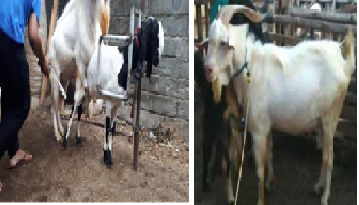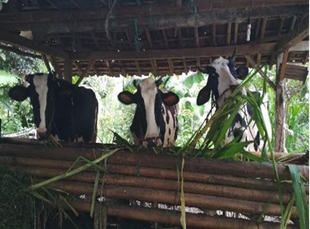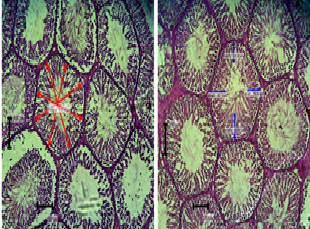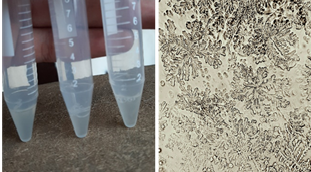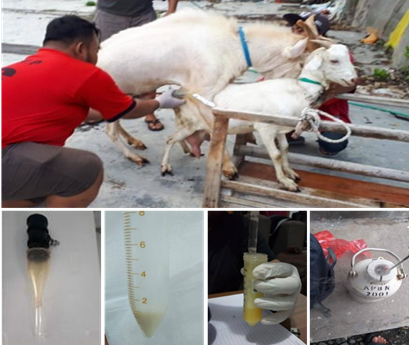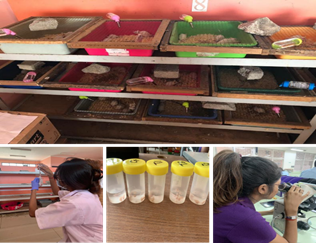Retained placenta in dairy cows living in an all-day cowshed rearing system

Downloads
This study aimed to determine the prevalence and factors that influence the incidence of retained placenta in dairy cows reared under an all-day cowshed housing system at KUD Tani Wilis, Sendang District, Tulungagung. This study used 216 dairy cows, that had already calved, that had been identified to have medical and reproductive records for data exploration. Data collected included the sex and weight of calf, single or twin calves, age of the dam, cowshed structure (floor, puddles on the floor, gutter, distance of cowshed to waste disposal, type of floor and roof, and sunlight exposure), feed of the dam (forage, concentrate, mineral supplements), frequency of retained placenta cases on calving intervals and days open of the dams. The prevalence of retained placenta was presented descriptively. Factors related to the retained placenta and its effect on calving interval and days open were analyzed by Chi-square test using Statistical Product and Service Solution (SPSS) software version 20 for Windows. The result showed that the prevalence rate of retained placenta was 19.91% of all dairy cow populations in the district. Furthermore, the sex of the calf, age of the dam, sunlight exposure, and the quantity of feed (forage and concentrate) were related to the retained placenta (p <0.05). In addition, retained placenta increased along with extending of days open and calving interval. It could be concluded that the factors that influenced the prevalence of retained placenta were the sex of the calf, the age of the cow, the feed and concentrate, and the cowshed that is not facing the sun.
Al-Yamani H, ALkarmah M, Koşum N. 2021. Some reproductive problems in Friesian cows raised in Yemen (2- retained placenta). Biomed J Sci Tech Res 40: 32548-54.
Amin YA, Elqashmary HA, Karmi M, Essawi WM. 2023. Different protocols in treatment of placental retention in dairy cows and their influences on reproductive performance. Reprod Domest Anim. 2023 Jun 18.
Attupuram NM, Kumaresan A, Narayanan K, Kumar H. 2016. Cellular and molecular mechanisms involved in placental separation in the bovine: A review. Mol Reprod Dev. 83: 287-97.
Bernardi F, Possa MG, Neto AP, de Oliveira W, Mota MF, Merlini LS, Martinez AC, de Souza RM. 2019. Risk factors involved in retained placenta of dairy cows from family agriculture herds. Braz. J. of Develop. 5: 18670-81.
Black RA, Krawczel PD. 2019. Effect of prepartum exercise on lying behavior, labor length, and cortisol concentrations. J Dairy Sci. 102: 11250-9.
Crowe MA, Mullen MP. 2013. Relative roles of FSH and LH in stimulation of effective follicular responses in cattle. In: Vizcarra J (Ed). Gonadotropin. IntechOpen. Crossref, doi:10.5772/50272.
CSA (Central Statistics Agency) Tulungagung Regency. 2022. Tulungagung Regency in Figures 2022. 26 January 2022.
Dhakal K, Maltecca C, Cassady JP, Baloche G, Williams CM, Washburn SP. 2013. Calf birth weight, gestation length, calving ease, and neonatal calf mortality in Holstein, Jersey, and crossbred cows in a pasture system. J Dairy Sci. 96: 690-8.
Eder K, Grundmann SM. 2022. Vitamin D in dairy cows: metabolism, status and functions in the immune system. Arch Anim Nutr. 76: 1-33.
Gohary K, LeBlanc SJ. 2018. Cost of retained fetal membranes for dairy herds in the United States. J Am Vet Med Assoc. 252: 1485-89.
Gonçalves RS, Guagnini F de S, Storck DJ, Brose M de M, Diaz Gonzales FH, Cabrebra Dalto AG. 2019. Risk factors associated to retained placenta in Holstein cows. Acta Scientiae Vet. 47: 13-24.
Henchion MM, Regan Á, Beecher M, MackenWalsh Á. 2022. Developing 'Smart' dairy farming responsive to farmers and consumer-citizens: A review. Animals 12: 360.
Islam MH, Sarder MJU, Jahan SS, Rahman M, Zahan M, Kader MA, Mozaffor Hossain KM. 2013. Retained placenta of dairy cows associated with managemental factors in Rajshahi, Bangladesh, Vet. World 6: 180-4.
Jovanović IB, VeliÄković M, Vuković D, Milanović S, ValÄić O, Gvozdić D. 2013. Effects of different amounts of supplemental selenium and vitamin E on the incidence of retained placenta, selenium, malondialdehyde, and thyronines status in cows treated with prostaglandin F2α for the induction of parturition. J Vet Med. 2013: 867453.
Kamel ER, Ahmed H, Hassan FM. 2022. The effect of retained placenta on the reproductive performance and its economic losses in a Holstein dairy herd. Iraqi J Vet Sci. 36: 359-65.
Kashoma IP, Ngou AA. 2021. Retained fetal membrane in Tanzanian dairy cows: Economic impacts and subsequent reproductive performances. J Vet Med Animal Sci. 4: 1059.
Khan MH, Manoj K, Pramod S. 2016. Reproductive disorders in dairy cattle under semi-intensive system of rearing in North-Eastern India. Vet World 9: 512-8.
Kumar PR, Singh SK, Kharche SD, Chethan Sharma G, Behera BK, Shukla SN, Kumar H, Agarwal SK. 2014. Anestrus in cattle and buffalo: Indian perspective. Adv Anim Vet Sci. 2: 124-38.
Li Y, Wen H, Yang Y, Zhao Z, Gao H, Li H, Huang M. 2022. Potential prognostic markers of retained placenta in dairy cows identified by plasma metabolomics coupled with clinical laboratory indicators. Vet Q. 42: 199-212.
Lodhi LA, Qureshi ZI. 2000. The Bovine Testes-II: Role of hormones during pre and post natal development. Pak J Biol Sci. 3: 1929-34.
Mahnani A, Sadeghi-Sefidmazgi A, Ansari-Mahyari S, Ghorbani GR, Keshavarzi H. 2021a. Farm and cow factors and their interactions on the incidence of retained placenta in Holstein dairy cows. Theriogenology 159: 87-97.
Mahnani A, Sadeghi-Sefidmazgi A, Ansari-Mahyari S, Ghorbani GR. 2021b. Assessing the consequences and economic impact of retained placenta in Holstein dairy cattle. Theriogenology 175: 61-8.
Martin SW, Meek AH, Willeberg. P. 1987. Veterinary epidemiology: Principles and methods. 1st Ed. Iowa State University Press. Iowa, USA.
Mekonnen M, Moges N. 2016. A review on dystocia in cows. Eur J Biol Sci. 8: 91-100.
Molina-Coto R, Lucy MC. 2018. Uterine inflammation affects the reproductive performance of dairy cows: A review. Agronomía Mesoamericana 29: 449-67.
Moraes JGN, Behura SK, Geary TW, Hansen PJ, Neibergs HL, Spencer TE. 2018. Uterine influences on conceptus development in fertility-classified animals. Proc Natl Acad Sci. 115: E1749-E1758.
Noya A, Casasús I, Ferrer J, Sanz A. 2019. Long-term effects of maternal subnutrition in early pregnancy on cow-calf performance, immunological and physiological profiles during the next lactation. Animals 9: 936.
Qu Y, Fadden AN, Traber MG, Bobe G. 2014. Potential risk indicators of retained placenta and other diseases in multiparous cows. J Dairy Sci. 97: 4151-65.
Raheem KA, Uchechukwu NVS, Odirichukwu E, Onyegbulam O. 2016. Placenta retention in the cow: Report of three cases. Sokoto J Vet Sci. 14: 72-6.
Rezende EV, Reis IJ, Campos CC, Santos RM. 2020. Influence of gestation length, seasonality, and calf sex on birth weight and placental retention in crossbred dairy cows. Ciíªncia Animal Brasileira 21: e-52881.
Sammad A, Khan MZ, Abbas Z, Hu L, Ullah Q, Wang Y, Zhu H, Wang Y. 2011. Major nutritional metabolic alterations influencing the reproductive system of postpartum dairy cows. Metabolites 12: 60.
Santosa B. 2002. Hubungan antara kejadian endometritis dan mastitis pada sapi perah (Studi kasus di PT Taurus Dairy Farm, Cicurug, Sukabumi). Skripsi. Institut Pertanian Bogor. Bogor, Indonesia.
Sharfina FA, Yusuf M. 2022. Faktor prioritas pengembangan komoditas susu sapi perah di kecamatan Sendang Kabupaten Tulungagung dengan konsep agribisnis. J Penataan Ruang 17: 13-8.
Skovorodin E, Mustafin R, Bogoliuk S, Bazekin G, Gimranov V. 2019. Clinical and structural changes in reproductive organs and endocrine glands of sterile cows. Vet World 13: 774-81.
Strickland JM, Wisnieski L, Mavangira V, Sordillo LM. 2021. Serum vitamin D is associated with antioxidant potential in peri-parturient cows. Antioxidants 10: 1420.
Tagesu A. 2018. Review on the reproductive health problem of dairy cattle. Dairy Vet Sci J. 5: 1-12.
Temesgen MY, Assen AA, Gizaw TT, Minalu BA, Mersha AY. 2022. Factors affecting calving to conception interval (days open) in dairy cows located at Dessie and Kombolcha towns, Ethiopia. PLoS One 17: e0264029.
Tucho TT, Ahmed WM. 2017. Economic and reproductive impacts of retained placenta in dairy cows. J Reprod Infertil. 8: 18-27.
Weir RR, Strain JJ, Johnston M, Lowis C, Fearon AM, Stewart S, Pourshahidi LK. 2017. Environmental and genetic factors influence the vitamin D content of cows' milk. Proc Nutr Soc. 76: 76-82.
Xiao J, Khan MZ, Ma Y, Alugongo GM, Ma J, Chen T, Khan A, Cao Z. 2021. The antioxidant properties of selenium and vitamin E; their role in periparturient dairy cattle health regulation. Antioxidants. 10: 1555.
Yang Z, Dong S, Zheng Y, Kong F, Lv J, Sun X, Wang Y, Cao Z, Wang W, Li S. 2022. Effects of concentrate levels in prepartum diet on milk performance, energy balance and rumen fermentation of transition Montbéliarde-Holstein crossbred cows. Animals 12: 1051.
Yusuf J J. 2016. A review on retention of placenta in dairy cattles. Inter J Vet Sci. 5: 200-7.
Copyright (c) 2023 Sayi Datur Rohmah, Hermin Ratnani, Sunaryo Hadi Warsito, Rimayanti Rimayanti, Sri Pantja Madyawati, Sri Mulyati, Abdullah Hasib

This work is licensed under a Creative Commons Attribution-ShareAlike 4.0 International License.
Ovozoa by Unair is licensed under a Creative Commons Attribution-ShareAlike 4.0 International License.
1. The journal allows the author to hold the copyright of the article without restrictions.
2. The journal allows the author(s) to retain publishing rights without restrictions
3. The legal formal aspect of journal publication accessibility refers to Creative Commons Attribution Share-Alike (CC BY-SA).
4. The Creative Commons Attribution Share-Alike (CC BY-SA) license allows re-distribution and re-use of a licensed work on the conditions that the creator is appropriately credited and that any derivative work is made available under "the same, similar or a compatible license”. Other than the conditions mentioned above, the editorial board is not responsible for copyright violation.





























